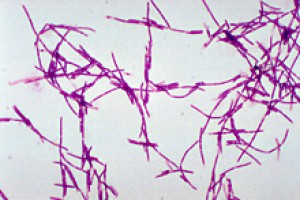How Sulfa Drugs Work
How Sulfa Drugs Work
Researchers have finally found out how sulfa drugs—the first class of antibiotics ever discovered—work at the molecular level. The finding offers insights into designing more robust antibiotic therapies.

Bacillus anthracis. Image courtesy of CDC/ Dr. William A. Clark.
Sulfa antibiotics were first used in the 1930s, and they revolutionized medicine. After a few years, bacteria started to develop resistance to the drugs, and eventually penicillin replaced them as a first-line treatment. While antibiotic resistance remains a problem for this class of antibiotics, sulfa drugs are still commonly used to treat a variety of bacterial infections.
Sulfa drugs work by binding and inhibiting a specific enzyme called dihydropteroate synthase (DHPS). This enzyme is critical for the synthesis of folate, an essential nutrient. Mammals get folate from their diet, but bacteria must synthesize this vitamin. Folate synthesis requires a chemical reaction between 2 molecules, DHPP and PABA, that is catalyzed by DHPS.
Bacteria resistant to sulfa drugs often have mutations in the DHPS enzyme. These mutations occur on 2 floppy loops that sit near the enzyme’s active site. Previous research had described most of the structure of DHPS, but the structure of the floppy, highly conserved loops remained elusive. Moreover, researchers didn’t know how the chemical reaction occurs between DHPP and PABA.
A team of scientists led by Dr. Stephen White of St. Jude Children’s Research Hospital set out to determine the structure of the loops and the chemical reactions that are helped along by DHPS. Their research, which appeared in the March 2, 2012, issue of Science, was funded primarily by NIH’s National Institute of Allergy and Infectious Disease (NIAID).
The scientists isolated the DHPS enzyme from 2 bacterial species: Bacillus anthracis, which causes anthrax, and Yersinia pestis, which causes plague. The scientists embedded DHPP and PABA in crystals of the enzyme. They then used X-ray crystallography to find high-resolution structures of these molecules at different stages of the chemical reaction.
The researchers found that the 2 floppy loops wrap around PABA early on and hold the molecule in place. The chemical reaction linking portions of PABA and DHPP takes place, and then the loops release the chemical reaction product. The structures also revealed the exact chemical reaction steps that occur between PABA and DHPP.
Sulfa antibiotics work because they fit into the DHPS active site and take PABA’s place. By embedding sulfa antibiotics into the enzyme crystals, the scientists found that the sulfa drugs are held in place by the floppy loop structures. However, a small portion of the drug sticks out of the binding pocket. The researchers discovered that DHPS mutations in drug-resistant bacteria occur near this small stuck-out portion.
“The structure we found was totally unexpected and really opens the door for us and others to design a new class of inhibitors targeting DHPS that will help us avoid side effects and other problems associated with sulfa drugs,” says White.
By Lesley Earl, Ph.D.
###
* The above story is reprinted from materials provided by National Institutes of Health (NIH)
** The National Institutes of Health (NIH) , a part of the U.S. Department of Health and Human Services, is the nation’s medical research agency—making important discoveries that improve health and save lives. The National Institutes of Health is made up of 27 different components called Institutes and Centers. Each has its own specific research agenda. All but three of these components receive their funding directly from Congress, and administrate their own budgets.



















